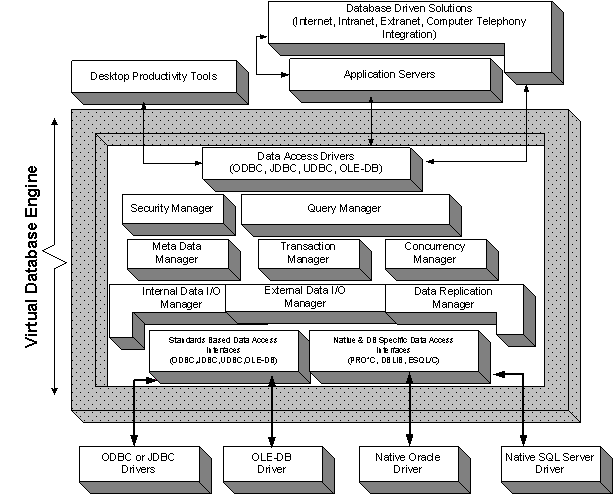8.1.4.VDB Engine Components
The prior section outlined the critical implementation issues that affect the development and implementation of VDB Engines. These issues form the basis around which a component based framework for depicting VDB architectures has been derived.
The components that comprise a VDB Engine framework are as follows:
Data Access Drivers
The VDB component that forms the entry point to the VDB Engine's services, these drivers may or may not conform to industry standards. Applications and Services that sit atop a VDB Engine must have their data access layers written to the same Application Programming Interfaces (APIs) implemented by the Data Access Drivers provided by a VDB engine.
Security Manager
The VDB component that is responsible for protecting data and data transmission (using encryption) within the VDB Engine's domain. It is also responsible for managing Application, User, Group, Role and Domain privileges as they relate to the creation, manipulation and destruction of VDB data and metadata.
Query Manager
The VDB component that handles queries presented to it by the VDB Engine's data access drivers. It provides query syntax checking, query execution plan compilation, and query fulfillment services. A query processor is built in conformance to one or more query language specifications, the most notable being the Structured Query Language (SQL) for relational database engines, and the Object Query Language (OQL) for Object-Relational and Object Database engines.
Meta Data Manager
The VDB component that provides the Query Processor with information about the data entities from which the Query Processor's execution plan is derived. Metadata managers are also the components responsible for linking external data sources into the VDB domain and directing the Query Processor to the appropriate Data I/O manager.
Transaction Manager
The Transaction Manager component ensures that transactions are Atomic (clearly distinguishable units), Consistent (thereby preserving integrity of data), Isolated from the effect of other transactions, and Durable (such that the effects of committed transactions survive failure). The Transaction Manager ensures VDB Engines are capable of supporting Online Transaction Processing (OLTP) and Distributed Transaction oriented applications and services. Transaction Managers may be standards based implementing X/Open's XA Resource Manager Specifications. Distributed transaction support is implemented by using a two-phase commit protocol.
Concurrency Manager
The VDB component that ensures client applications and services are capable of opening multiple concurrent sessions that execute data INSERTS, UPDATES and DELETIONS, without implicitly reducing application response times or compromising data integrity. Concurrency control is delivered in one of two formats, Optimistic or Pessimistic depending on the response times desired by VDB client applications or services.
Local Data I/O Manager
VDB Engine's that provide local data storage uses this component for reading and writing data to disk. This is how a VDB provides traditional database engine data storage services.
External Data I/O Manager
VDB component that handles data reads and writes to external data sources. The External Data I/O Manager be implemented using standard data access interfaces such as ODBC, JDBC, UDBC, OLE-DB or Native data source interfaces.
Replication Manager
Component that manages data migration and synchronization across two or more VDB servers within a distributed computing environment. This component acts as a data coordinator between the activities of Local Data I/O and External Data I/O Managers across VDB servers. The Replication Manager enables a VDB Engine offer automated bi-directional data, and metadata transformation services across heterogeneous data sources without end-user or developer intervention.
Figure8.2.Virtual Database Engine Architecture & Components
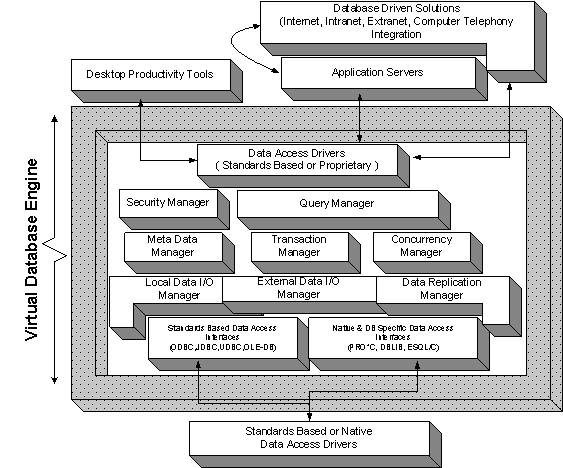
VDB Implementation Approaches
There are no golden VDB implementation specifications, but the implementation of a VDB has a direct impact the degree to which you realize desired value from the VDB concept as a whole.
The VDB value proposition is simply stated as follows:
"To provide transparent access to heterogeneous data sources, independent of host operating system and underlying database engines ".
VDB implementations can be categorized as follows:
Table8.1.VDB Implementation Categories
| VDB Data Access Interface | VDB External Data I/O | Traditional Database Functionality | |
|---|---|---|---|
| Type 1 | Native | Native | Partial |
| Type 2 | Native | Native | Full |
| Type 3 | Native | Standards Based | Partial |
| Type 4 | Native | Standards Based | Full |
| Type 5 | Standards Based | Native | Partial |
| Type 6 | Standards Based | Native | Full |
| Type 7 | Standards Based | Standards Based | Partial |
| Type 8 | Standards Based | Standards Based | Full |
| Type 9 | Standards Based | Standards Based or Native | Partial |
| Type 10 | Standards Based | Standards Based or Native | Full |
The sections that follow provide illustrations of the different VDB formats, depicting the components that provide the basis for the categorization used in the table above.
Type 1 VDB Engine
This category of VDB exposes its services to clients via Native and Proprietary high-level data access interfaces. Data I/O is achieved via native, proprietary, and data source specific low-level data access interfaces. This category of VDB does not possess a complete set of traditional database engine components.
Figure8.3.Type 1 VDB Engine Architecture
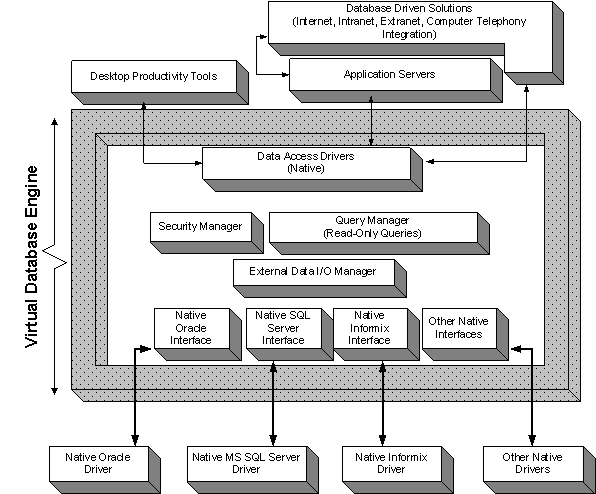
Type 2 VDB Engine
This category of VDB exposes its services to clients via Native and Proprietary high-level data access interfaces. External data I/O is achieved via native, proprietary, and data source specific low-level data access interfaces. This category of VDB possesses a complete set of traditional database engine components.
Figure8.4.Type 2 VDB Engine Architecture
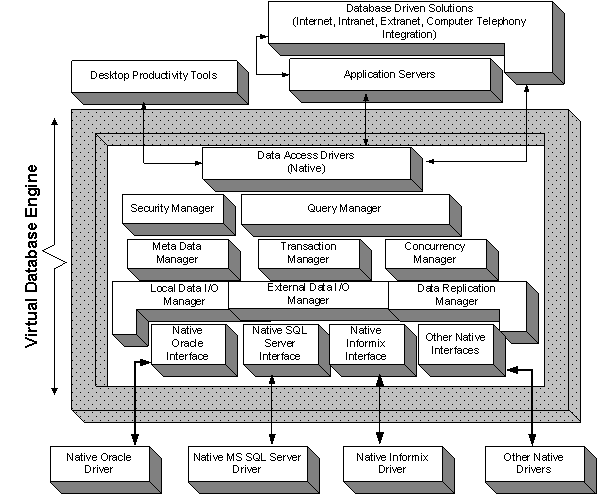
Type 3 VDB Engine
This category of VDB exposes its services to clients via Native and Proprietary high-level data access interfaces. Data I/O is achieved via Open, Standards based, and Database Independent low-level data access interfaces. This category of VDB does not possess a complete set of traditional database engine components.
Figure8.5.Type 3 VDB Engine Architecture
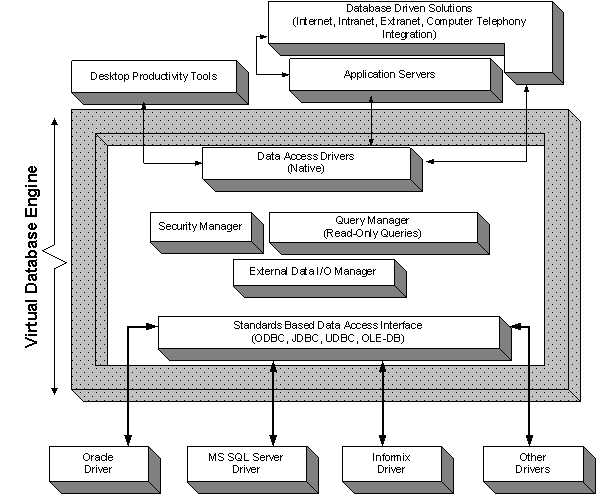
Type 4 VDB Engine
This category of VDB exposes its services to clients via Native and Proprietary high-level data access interfaces. External data I/O is achieved via Open, Standards based, and Database Independent low-level data access interfaces. This category of VDB possesses a complete set of traditional database engine components.
Figure8.6.Type 4 VDB Architecture
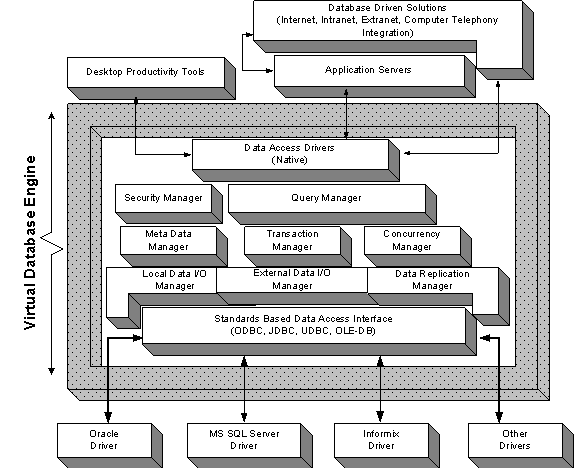
Type 5 VDB Engine
This category of VDB exposes its services to clients via open and standards based high-level data access Interfaces. Data I/O is achieved via native, proprietary, and data source specific low-level interfaces. This category of VDB does not possess a complete set of traditional database engine components.
Figure8.7.Type 5 VDB Engine Architecture
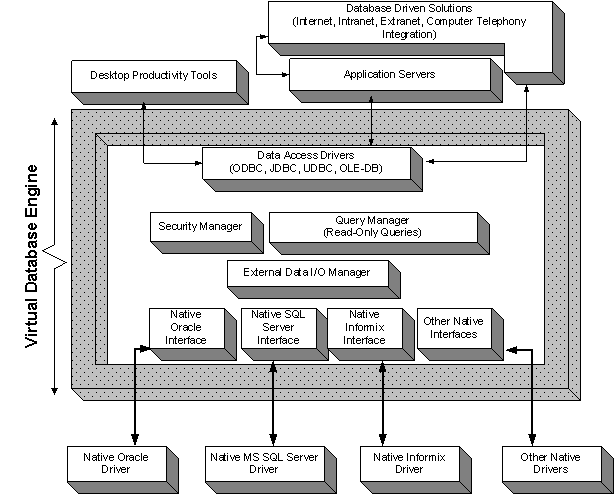
Type 6 VDB Engine
This category of VDB exposes its services to clients via open, standards based, high and low-level Interfaces. External data I/O is achieved via native, proprietary, and data source specific low-level interfaces. This category of VDB possesses a complete set of traditional database engine components.
Figure8.8.Type 6 - VDB Engine Architecture
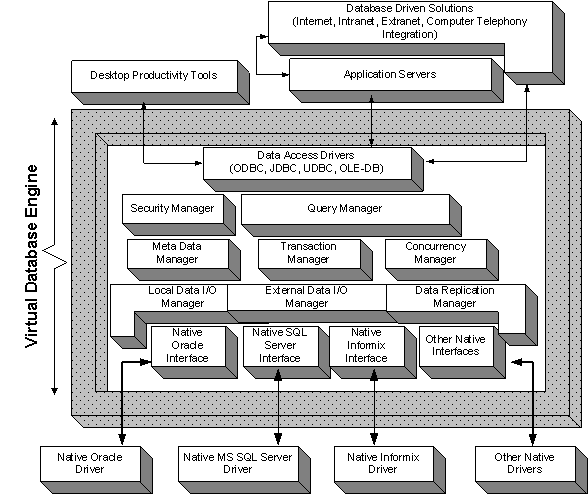
Type 7 VDB Engine
This category of VDB exposes its services via open, standards based high-level data access interfaces. Data I/O is achieved via Open, Standards based, and Database Independent low-level data access interfaces. This category of VDB does not possess a complete set of traditional database engine components.
Figure8.9.Type 7 VDB Engine Architecture
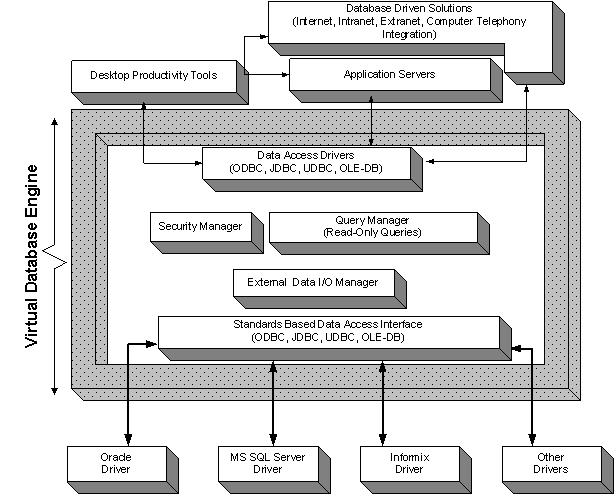
Type 8 VDB Engine
This category of VDB exposes its services via open, standards based, high and low-level interfaces. External data I/O is achieved via Open, Standards based, and Database Independent low-level data access interfaces. This category of VDB does possess a complete set of traditional database engine components.
Figure8.10.Type 8 VDB Engine Architecture

Type 9 VDB Engine
This category of VDB exposes its services via Open, Standards based, high-level data access interfaces. Data I/O is achieved by using either Open, Standards based, and Database Independent low-level data access interfaces or Native, Proprietary, and Database Specific low-level data access interfaces. This category of VDB does not possess a complete set of traditional database engine components.
Figure8.11.Type 9 VDB Architecture

Type 10 VDB Engine
This category of VDB exposes its services via Open, Standards based, high-level data access interfaces. External data I/O is achieved by using either Open, Standards based, and Database Independent low-level data access interfaces or Native, Proprietary, and Database Specific low-level data access interfaces. This category of VDB possesses a complete set of traditional database engine components.
Figure8.12.Type 10 VDB Architecture
